What’s New in Material, Equipment Transport?
BY Sandy Lender
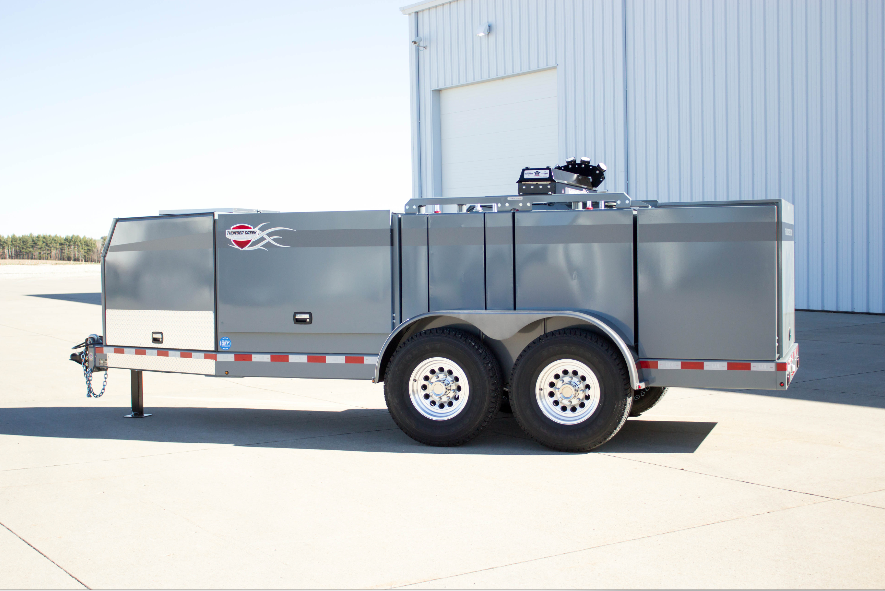
Gone are the days when you would drive the paver from one section of a paving project to another section two or three miles down the road. Instead, the supervisor for the project arranges to have a low bed trailer in the staging area to transport the paver and rollers to the second site. In fact, a low bed is probably sitting at the yard with a back-up paver, skid steer, roller or whathaveyou on standby so any equipment breakdowns will have minimal impact on productivity. Equipment haul trailers: they’re not just for the first setup anymore. Just as contractors keep finding new ways to put their equipment haul trailers into use, OEMs keep making tweaks and updates to improve the trailers. A few of those OEMs responded to this month’s showcase to share their updates with you.
In addition to equipment hauling, trucks and trailers haul the perishable material that is the lifeblood of our industry—asphalt mix. This month’s Safety Spotlight shared tips for keeping the haul truck in top condition, but let’s take a look at the truck’s driver for a minute. Depending on which part of the country you’re in, that person may be difficult to find.
Jerry Peterson of the Texas Department of Transportation shared with the attendees of the 9th Argus Americas Asphalt Summit March 3 one of the pressures contractors in his state face when it comes to hauling material. The oil exploration boom has led to a shortage of drivers available to the asphalt and aggregate industry as oilfield management companies hire the CDL drivers at wages with which contractors can’t compete. While independent drivers of tri-axles may already have been out of price range at $75 or $85 an hour on state jobs, imagine asking a driver to take the lower end when the oil companies can double the high end. What skill level are you left with?
Contractors also need to keep an eye on hours-of-service for drivers. While resting period legislation is geared toward over-the-road drivers, construction industry members have been seeking clarification for its application to those drivers delivering materials to work zones, etc. Truck Parking Europe recently teamed up with Tom Tom to make its popular TPE app available for TomTom PRO 8 and TomTom BRIDGE driver terminals. This app shows where all truck parking spots are alongside TomTom’s Remaining Driving Time (RDT) app. This means drivers can see when their next stop is due and where they can safely park for a rest. The company said TPE is already available for smartphones and had been downloaded more than 150,000 times; however, it was made available for dedicated truck navigation devices in March of this year. The unfortunate part is it’s for Europe. The more unfortunate part is none of the OEMs contacted for this month’s showcase could comment on the availability of such a telematics option in the United States.
Let’s not brush past the hours-of-service concept too quickly. The U.S. Department of Transportation’s Federal Motor Carrier Safety Administration (FMCSA) federal regulations to reduce truck driver fatigue took full effect three years ago this month, yet have had some rest-period language redacted since then. In addition, the Consolidated and Further Continuing Appropriations Act of 2015—enacted Dec. 16, 2014—suspended enforcement of requirements for use of a 34-hour rest period, or “restart,” after a 60/70-hour work week for property-carrying drivers. Construction industry groups still seek clarification on how all that affects drivers in this industry. Do drivers delivering asphalt from 6 a.m. to 4 p.m. have to stop and take a 30-minute break? That answer is not cut and dry. First, look at the rules. According to the Transportation.gov website, FMCSA’s hours-of-service final rule:
- limits the maximum average work week (7/8 days) for truck drivers to 60/70 hours;
- requires truck drivers to take a 30-minute break during the first eight hours of a shift; and
- retains the current 11-hour daily driving limit and 14-hour work day.
Of course haul truck drivers for asphalt companies and independent truck drivers delivering construction materials have different operations than long haul, over-the-road truck drivers, for whom the HOS limitations have been set. The Transportation.gov website reported: “Only the most extreme schedules will be impacted, and more than 85 percent of the truck driving workforce will see no changes.” A spokesperson for the National Asphalt Pavement Association (NAPA) shared that the short haul and construction materials exemption allows drivers to forgo the 30-minute break. After 24 hours, the driver’s clock “restarts.” The construction industry wants to be in compliance, though.
We also want to be smart. If a driver has been performing the round-robin circuit to get mix from the plant to the paver for seven, eight or nine hours, of course he needs a break for lunch somewhere in there. We may be working with a perishable material with an expiration time, but we’re also working with human beings who need bathroom breaks and lunch time to refuel and re-energize. That’s easy enough to schedule into the round-robin of the shift overall.
Alongside management of equipment arrival, safety and mix delivery, you can consider upgrades to the trucks and trailers available for it all
From Freightliner®/Daimler Trucks North America LLC, Portland.
Detroit™ Connectivity and Detroit Engine Power keep Freightliner 114SD® moving through innovative technology. Consider: The trouble with check engine lights is that they’re often vague. They can signal anything from an easy fix to a critical engine failure, so it’s hard for drivers hauling a load of asphalt to a job to know what to do. Detroit Connect Virtual Technician℠ is designed to put an end to the guessing game with an integrated remote diagnostic system. This telematics solution, available on Freightliner trucks, records data immediately before, during and after a fault occurs, and notifies the fleet manager or driver of the severity of the issue.
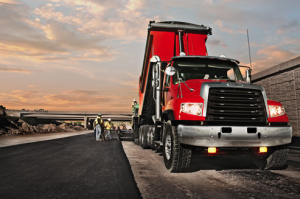
A Freightliner 114SD haul truck charges the hopper with mix, delivered on-time thanks to Detroit Connect Virtual Technician monitoring for optimum uptime.
Fleet managers have reported that equipping their trucks with Detroit Connect Virtual Technician has helped make their jobs easier. If there’s a major issue, they get an email right away, which allows them to get their guys out to the truck and get it back up and running. If there’s a minor code that won’t affect the operation of the truck, they can keep it in service and take care of the issue that evening. Furthermore, a fleet can continue to grow under the direction of one fleet manager due to the visibility and efficiency offered by Detroit Connect Virtual Technician.
They also have reported a noticeable difference in uptime and a lower Real Cost of Ownership℠. If a truck goes down in the middle of the day, it’s likely to miss the delivery window of perishable material. The cost of lost materials plus any expenses to remove mix from the truck can add up quickly. On top of that, the client may suffer a productivity loss because the materials never arrived. Detroit Connect Virtual Technician can help prevent these losses.
Spec’ing the right vocational truck with the right engine and powertrain has a major impact on the profitability of businesses that count on heavy-duty vehicles. The Freightliner 114SD equipped with Detroit Connect Virtual Technician is a great choice for haul trucks and trailers, like those that handle road resurfacing and construction projects, according to the manufacturer. The 114SD has the option for a Detroit DD13® engine with up to 470 horsepower. This engine is specifically designed for construction, in-town and less-than-load. It stands out for its best-in-class fuel economy, up to 50,000-mile service intervals, and proven emissions technology integration.
- Use this to deliver mix.
- For more information, contact Richard Saward at (803) 578-3518 or saward@daimler.com. Let them know you saw it in AsphaltPro magazine.
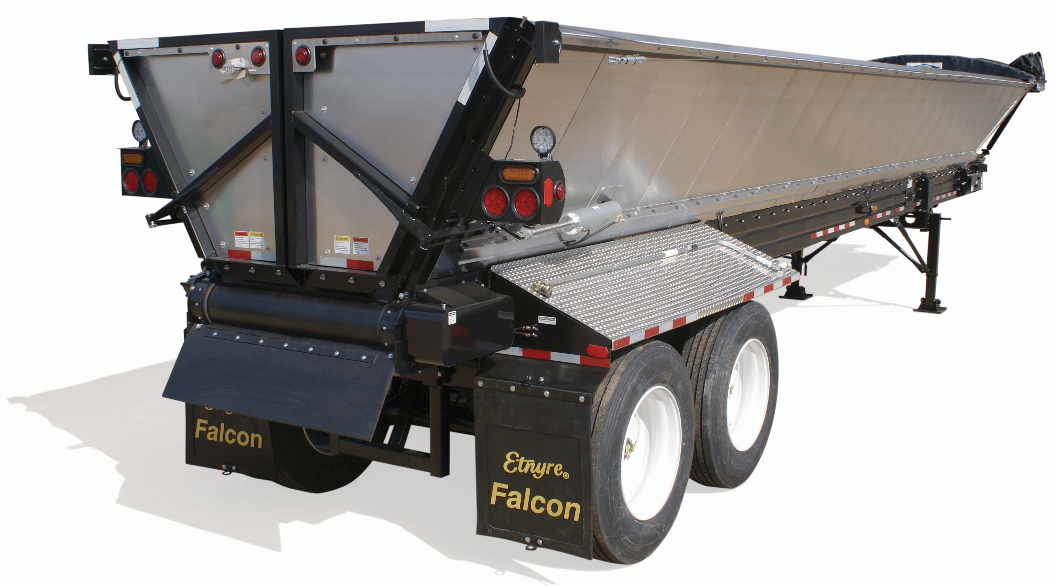
The Falcon live bottom belt trailer from E.D. Etnyre & Company, Oregon, Ill., is designed to deliver mix without raising the body up, offering safe, continuous operation even under power lines and bridge decks.
From E.D. Etnyre & Company, Oregon, Ill.
The Etnyre Company makes Falcon live bottom belt trailers and truck bodies in many different lengths and capacities, with a wide range of axle configurations to fit individual customer requirements both domestically and internationally. Falcon live bottom belt trailers are designed and manufactured with a unique conveyor drive system to deliver asphalt, aggregate and other construction materials. As well as a single swing up rear door, Etnyre provides a unique twin swing open “barn” style door system that forms a natural funnel to direct the load. Falcon belt trailers with the twin door system are popular in asphalt paving operations, according to the manufacturer. Etnyre live bottom belt trailers unload without raising the body up to dump the load, which allows continuous safe operation under power lines, trees, tunnels and bridges.
- Use this to deliver mix.
- For more information, contact Kevin Sassaman at ksassaman@etnyre.com. Let them know you saw it in AsphaltPro
From Talbert Manufacturing, Rensselaer, Ind.
Talbert launched a new air ramp (Air) tilt series trailer for easy loading of low-clearance equipment, such as soil and asphalt rollers in September 2015. The series includes the 20-ton capacity AC-20-ART and 25-ton capacity AC3-25-ART. The units’ air controls are designed to provide additional operator safety when raising and lowering the trailer for loading, and its low deck height is designed to offer a superior view of the equipment and surroundings.
“We received several requests for heavy-duty, tilt-deck trailers with a reduced load angle,” Troy Geisler, Talbert’s vice president of sales and marketing said. “Because of that, we developed the ART series as the heavy-haul solution.”
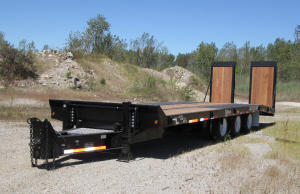
Talbert Manufacturing’s AC3-25-ART, the company’s newest Air Ramp (Air) Tilt Series trailer model, features an ultra-low load angle of 7 degrees with a 33-inch deck height for optimal view of the equipment and surroundings while hauling.
The series features Talbert’s lowest load angle, 7 degrees, for loading and unloading equipment weighing as much as 25 tons. Operators use the trailer’s controls, which use air power to fill bags near the front of the trailer to raise the deck and lower the ramps to the ground. The air-powered ramps eliminate handling heavy ramps and using cranes or other equipment to position loads. Operators drive equipment over the 38-inch-wide, high-density Apitong wood-filled ramps and onto the trailer deck. The unit’s wheels rest on the gripped floor plates over the trailer wheels for weight balance. Once the equipment is loaded, operators use the controls to return the ramps to the upright position.
The low 8-inch headboard and 33-inch deck height are designed to provide operators with a view of the equipment and surroundings to maximize safe operations. The low deck height also provides additional clearance for bridges and tunnels when transporting tall equipment. It allows haulers to expand the range of equipment transported while complying with U.S. and Canadian hauling requirements.
For additional safety and driver comfort while hauling, an air brake system and hutch spring suspension provide maximum load control. Operators secure loads by using safety chains with hooks that latch to tie-down rings on top of the outside beams. The ART series trailers come standard with Valspar R-Cure® 800 paint in Talbert’s signature red or black. Customers can add the optional Valspar AquaGuard™ for additional corrosion protection.
- Use this to transport equipment to your work site.
- For more information, contact Troy Geisler at (219) 866-7141 or sales@talbertmfg.com. Let them know you saw it in AsphaltPro
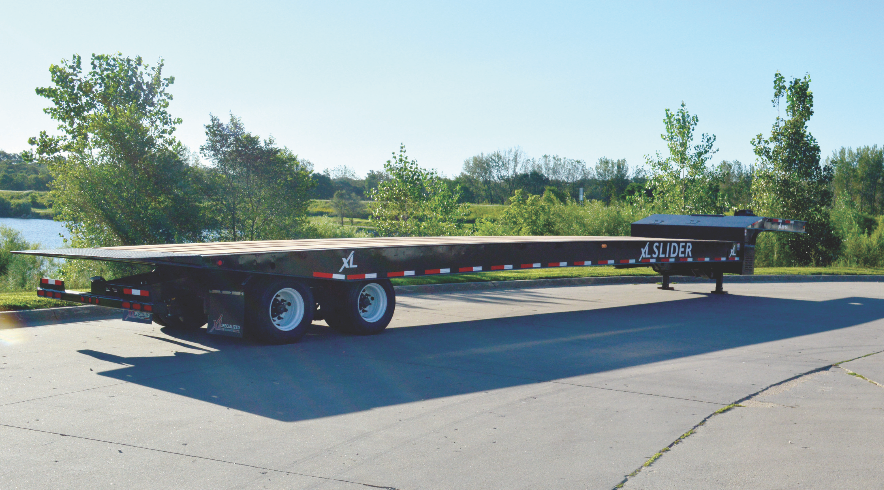
The XL 80 Slider from XL Specialized Trailers features new GAR-MAX filament-wound composite rollers, which are designed to slide smoothly without the need for grease. The trailer offers a low load angle of 6.5 degrees.
From XL Specialized Trailers, Manchester, Iowa
New GAR-MAX filament-wound composite rollers on the XL 80 Slider from XL Specialized Trailers are designed to slide smoothly without the need for grease. The two-axle trailer is rated at 80,000 pounds overall. It’s named for its sliding axle assembly, which allows the unit to tilt for the loading and unloading of heavy and inoperable equipment.
Paving equipment presents unique challenges with large rollers and heavy weights that require a full width ramp and low angle for loading. The XL Slide Axles offer a low load angle of 6.5 degrees to assist with loading such equipment.
“The XL 80 Slider will be a great trailer for the towing, aggregates and rental markets with its customized solutions,” Rodney Crim said. He’s the vice president of sales at XL Specialized Trailers. “Machines like paving equipment can be a headache to load, but the sliding and tilt mechanisms will really simplify loading for the operator and make it a much quicker operation.”
It is set up for hauling inoperable equipment, which requires winches and rollers for loading. It also offers a heavy-duty, 20,000-pound hydraulic winch with manual kick out and 100 feet of 9/16-inch cable. A two-function wireless remote accompanies the winch for ease of use and a recessed roller at the top of the gooseneck rolls in conjunction with the winch to pull the cable. Close cross member spacing enables drivers to transport forklifts.
The XL 80 Slider is a four-beam trailer comprised of 4-inch junior I-beams and 3-inch I-beams on 8-inch centers for durability. The trailer includes many standard features for easier operation. Chain drops down the center deck and the side beams provide extra tie-down areas. The energy chain protects air and electrical lines from damage, while two toolboxes in the upper deck provide storage space. The Slider comes with mid-turn lights, clearance lights and two tail lights; all rubber mounted with “plug-and-play” capability.
Additional options include: dock levelers, a 28-horsepower Honda self-contained power unit, hydraulic park stands, a wired remote for backup or an upgraded six, seven or 10-function wireless remote, and aluminum wheels. Operators choose from a 48-foot long version with a 15-degree dump angle. The XL-Slider offers two axle spacing options: 50 inches and 60 inches.
XL Specialized Trailers is committed to custom engineering trailers that work across North America, according to the manufacturer. In the West, XL manufactures a California-legal trailer that is 51 feet long; Canadian customers can choose the R-tac legal trailer that is 51 feet long with a 9-foot-wide deck.
- Use this to transport equipment to your work site.
- For more information, contact sales at (563) 927-4900 or visit www.xlspecializedtrailer.com. Let them know you saw it in AsphaltPro magazine.
From Thunder Creek Equipment, Pella, Iowa
The service and lube trailer (SLT) from Thunder Creek Equipment has a new chassis, new front-end design, expanded storage in the front and rear utility boxes, and a modular design that allows owners to add their own new components as well. Take a look.
The new SLT features a modular tank design that is capable of holding 440 gallons of fluid in up to eight tanks with combinations of 25, 55 and 110 gallons. This can include tanks for diesel fuel, oil delivery (engine or hydraulic), used oil reclamation, grease delivery, antifreeze, DEF and other fluids based on field maintenance needs.
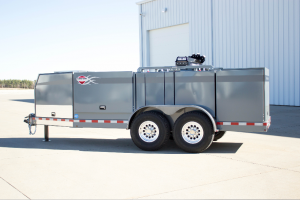
The service and lube trailer (SLT) from Thunder Creek Equipment has a new chassis, new front-end design and additional upgrades to give contractors optimized fleet management options.
“The Thunder Creek SLT provides a significantly lower total cost of ownership compared to full-sized lube trucks with similar capacities and functions,” Luke Van Wyk said. He’s the general manager of Thunder Creek Equipment. “We give equipment managers the flexibility to customize their trailer with up to eight fluids, plus separate solutions for DEF and grease in the newly expanded front and rear compartments….It is one of the most comprehensive field maintenance solutions available to heavy equipment fleet operations today.
“The ability for owners to field-install many of these options after their purchase, such as the DEF system and the rear utility box, further allows the trailer to grow with their field service needs.”
The redesigned front-end allows for an additional 100-gallon DEF storage tank and Thunder Creek’s proprietary 2-in-1 closed DEF distribution system. This can either be included at the time of purchase or field-installed at a later date.
In addition to fluid delivery, the SLT is outfitted with either a combination generator/air compressor or an optional 3-in-1 welder/generator/air compressor. This helps power the pneumatic pumps for fluid delivery, and other jobsite tools needed for field maintenance. An optional WorkSight Light Tower with LED lights is also available for performing service work at night.
The SLT retains many of the design and performance features of the previous model, including 10-gauge steel tanks, interior LED lighting, and the pneumatic pumping system with reels up to 75-feet long. The trailer can be purchased without the rear utility box and combination generator/air compressor for those who prefer to run the air off of their truck.
The redesigned front-end and chassis helps make the trailer more maneuverable, and it features better access to working areas via hatch-style doors and ergonomically positioned components. The fenders are removable, and holes are pre-drilled into the frame to move the axle position and ensure proper weight distribution for owners who add features after the initial purchase. The new SLT is manufactured in Pella, Iowa, and features Thunder Creek’s three-year tank warranty.
- Use this to manage your equipment fleet.
- For more information, contact sales at (866) 535-7667 or visit ThunderCreek.com. Let them know you saw it in AsphaltPro
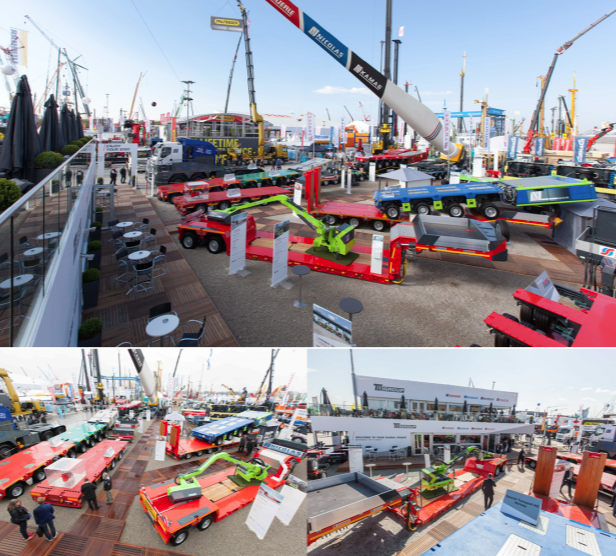
Trailers with hydraulically supported pendulum axles at the TII Group stand at BAUMA showcased the new maintenance-free independent suspension and self-propelled modular transport systems.
From TII Group, Heilbronn, Germany
Technological innovations were on tap at BAUMA 2016 for TII Group, which comprises Scheuerle, Nicolas, Kamag and Tratec. The group introduced the first maintenance-free independent suspension for heavy-duty operations, according to the manufacturer, as well as a self-propelled modular transporter (SPMT) with a continuously extendable width of up to 6.40 meters and an additional drive system (PowerBooster) for modular vehicles with 1,000 horsepower.
Bernd Schwengsbier, president of TII sales, said, “Successfully combining proven and innovative products, thus giving our customers an edge over their competitors—this is the idea behind the vehicles that we presented at BAUMA. The maintenance-free EuroAxle independent suspension and the continuously extendable SPMT Split are the best examples of this. While the competition are still waiting or their vehicles are being modified, our customers are already dealing with the next transport job, and thus increasing vehicle utilization.”
- Use this to haul large equipment/loads.
- For more information, contact Christopher Rimmele at Christopher.rimmele@tii-group.com. Let them know you saw it in AsphaltPro
